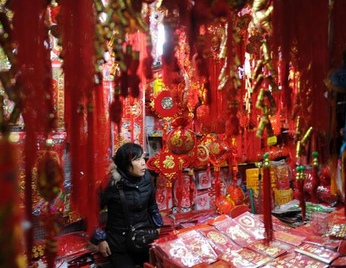
New Year Festival Time
Using the Chinese lunar calendar, Chinese New Year starts with the New Moon on the first day of the New Year and ends on the full moon 15 days later. The 15th day of the New Year is called the Lantern Festival, which is celebrated at night with lantern displays and children carrying lanterns in a parade.The Chinese New Year Celebrations span across 15 days with each day having its individual significance. New Year’s Eve and the first day of the New Year (Thursday 30 January and Friday 31 January) are the highlights in terms of festivities.
Quick history of New Year Celebrations
The Spring Festival was started when people offered sacrifice to ancestors in the last month of Chinese lunar calendar. With almost all the farming work done and with some free time to themselves, people prepared the sacrifice to the ancestors by doing thorough house cleaning, having baths, buying new clothes - an overall "spring clean". The specific sacrificing date changed according to the farming schedule and was not fixed until the Han Dynasty (202BC-220AD). People also began worshipping varies deities and held all kinds of ceremonies to welcome the arrival of Spring. The custom of worshipping deities and ancestors remains even though the ceremonies are not as grand as before.
Tradition, Red and Firecrackers
According to legend in ancient China, the "Nian" (meaning year) was a man-eating beast dwelling in the mountains (in other versions living under the sea), which came out every 12 months somewhere close to winter to prey on humans. People were naturally afraid and hid on the evening the "Nian" was out on the prowl for food. Later people believed that the Nian was sensitive to loud noises and the colour red, so they scared it away with explosions, fireworks and the abundant use of the colour red. These customs led to the first New Year celebrations. "Guo nian", which means to celebrate the new year, literally means the passover of the year.
Using the Chinese lunar calendar, Chinese New Year starts with the New Moon on the first day of the New Year and ends on the full moon 15 days later. The 15th day of the New Year is called the Lantern Festival, which is celebrated at night with lantern displays and children carrying lanterns in a parade.The Chinese New Year Celebrations span across 15 days with each day having its individual significance. New Year’s Eve and the first day of the New Year (Thursday 30 January and Friday 31 January) are the highlights in terms of festivities.
Quick history of New Year Celebrations
The Spring Festival was started when people offered sacrifice to ancestors in the last month of Chinese lunar calendar. With almost all the farming work done and with some free time to themselves, people prepared the sacrifice to the ancestors by doing thorough house cleaning, having baths, buying new clothes - an overall "spring clean". The specific sacrificing date changed according to the farming schedule and was not fixed until the Han Dynasty (202BC-220AD). People also began worshipping varies deities and held all kinds of ceremonies to welcome the arrival of Spring. The custom of worshipping deities and ancestors remains even though the ceremonies are not as grand as before.
Tradition, Red and Firecrackers
According to legend in ancient China, the "Nian" (meaning year) was a man-eating beast dwelling in the mountains (in other versions living under the sea), which came out every 12 months somewhere close to winter to prey on humans. People were naturally afraid and hid on the evening the "Nian" was out on the prowl for food. Later people believed that the Nian was sensitive to loud noises and the colour red, so they scared it away with explosions, fireworks and the abundant use of the colour red. These customs led to the first New Year celebrations. "Guo nian", which means to celebrate the new year, literally means the passover of the year.

 RSS Feed
RSS Feed
